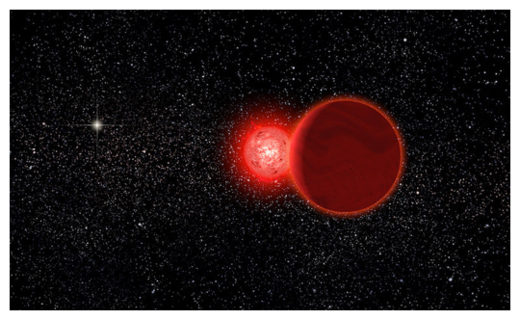
© Michael Osadciw/University of RochesterArtist's conception of Scholz's star, and its brown dwarf companion (foreground), during a flyby of our solar system some 70,000 years ago.
Stars jostling around the galaxy aren't quite like a cosmic game of pool. But they do have occasional near misses as they speed past each other. Back when spears and stone points were the height of human technology, astronomers say,
our solar system had a close encounter of the interstellar kind.The brief visitor was Scholz's star, and it might have grazed the outer edge of the solar system's distant Oort Cloud about 70,000 years ago - carrying its companion, a likely brown dwarf, along for the ride.It's unclear whether the near miss was close enough to give objects in the Oort Cloud, our solar system's halo of dormant comets, a gravitational nudge to fall toward the Sun. But the interstellar trespasser highlights a sometimes-forgotten reality: On long time scales, stars seem to fly around like sparks from a campfire, occasionally coming close enough to disturb each other's cometary clouds.
Such close passes could have profound implications for exoplanets - planets orbiting other stars - and how they got where they are. At least some of the time, an interloper could become a thief, stripping a star of one or more planets - or vice versa.
Our solar system, too, might have been shaped and sculpted by stellar flybys.
A 2018 study showed that the orbital motions of some of our solar system's small bodies appear still to bear the imprint of Scholz's gravitational wake. And some planet-like objects in the
Kuiper belt, the collection of rocky and icy bodies past the orbit of Neptune, could have been stolen from another star far earlier - in fact, soon after our Sun was born. Scholz's flyby could just be the latest in a series.
The discovery of our star-crossed close encounter was almost as random as the event itself.


Comment: According to Wiki it seems mirages in the Arctic may be more common than we think: The National Snow and Ice Data Center details how these mirages are formed in the Arctic: Although the Finnish coast guard could be forgiven for assuming it was either a mirage or a new island, because nearly every day unusual events are being documented that confirm our planets changing atmosphere, and its geography. But we can't say for sure whether or not this mirage is typical for the region or reflective of these new conditions: